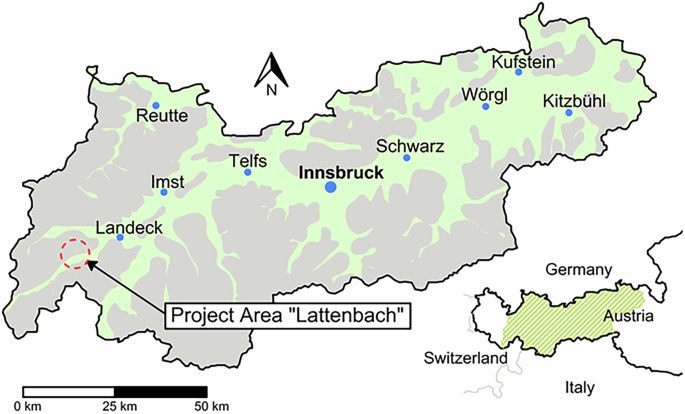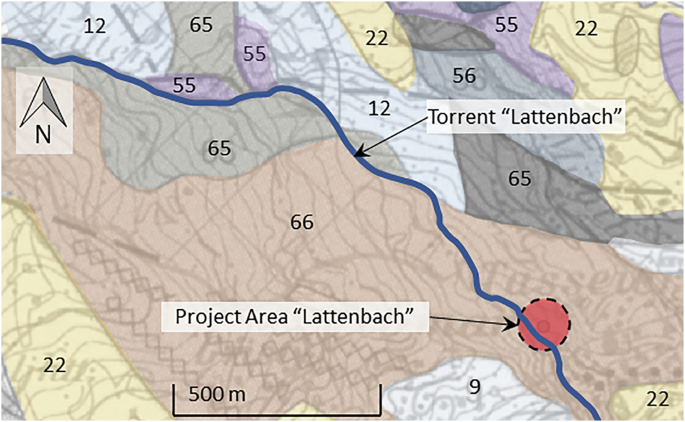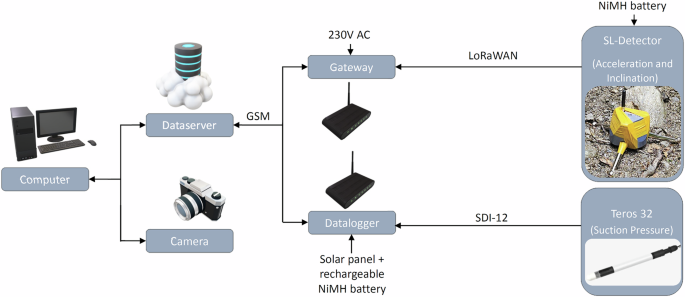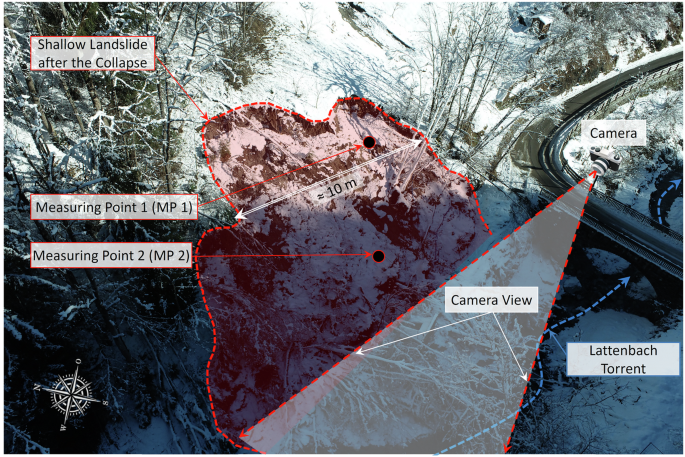The occurrence of rainfall-induced landslides has noticeably increased due to climate change, posing an escalating economic and social threat to infrastructure, railway lines, and roads1,2. These landslides not only create substantial risks for transportation routes but also lead to high costs for maintenance and restoration3,4,5,6,7. The threat of track closures on railways, road blockages, and the substantial annual expenditures required for clearing transport routes represent a growing challenge for infrastructure managers in the future. Well-documented triggers such as precipitation, cumulative rainfall, temperature fluctuations, snow cover, slope inclination, and, most importantly, the geotechnical properties of the subsurface are fundamental to the occurrence of mass movements and the activated soil volume. The relationship between matric suction, soil moisture, shrink-swell properties of the soil, and landslide activity has been extensively studied8,9,10,11,12,13,14,15. This study examines these interactions using the developed measurement system, which is labelled in the following as the Shallow Landslide Detector (SL-Detector) and its integrated data acquisition system. Based on laboratory and field experiments, as well as measurements from autonomous data collection systems, geotechnically and hydraulically coupled hypotheses for detecting the mobilisation of the primary objective is to establish a correlation between landslide movements recorded by the SL-Detector and the measured suction data for the purpose of early warning and alarm activation in practical applications.
This study further analyzes the relationship between suction /pore water pressure and the motion data from the SL-Detector sensors to assess their applicability for future alarm systems. Laboratory tests form the basis are used for coupled geotechnical-hydraulic assessment15,16,17,18,19. Parameters such as saturation, shrink-swell behaviour, and grain size distribution are crucial for holistic assessments20,21,22,23. During dry periods, suction increases, typically within the upper 1 to 3 metres of the subsurface24. This stabilising effect, particularly in cohesive and mixed-grain soils, can disappear at different rates during precipitation and snowmelt phases, potentially with a time lag25. The central research question concerns the rate at which suction decreases during wet periods, its timely recovery in dry phases, and the feasibility of predicting landslide events based on observable surface movements. Findings from both the authors’ projects and existing literature26 indicate that suction and moisture sensors are generally unsuitable for direct landslide alarm applications but remain indispensable for process modelling27,28.
The overarching goal of this research project is to analyse the process differences of shallow landslides under varying subsurface conditions and slope inclinations using a series of test sites, ultimately providing a data foundation for risk assessment. However, additional dry and wet periods at the different test sites must be observed, and continuous monitoring is required. It is well established that predicting shallow landslide events remains highly challenging. This paper presents and analyses data from the first of several instrumented test sites, located in the Landeck district of Tyrol (Fig. 1). At the other test sites, no slope failures have been observed under naturally occurring conditions, as the recorded precipitation has so far been insufficient to induce shallow landslides. Therefore, the results presented here are limited to the first test site, where slope activity has been observed under naturally occurring conditions. In December 2023, following adverse weather conditions, a landslide was triggered at the first studied test site.
Position of the project area “Lattenbach” in Tyrol (Austria) adapted from76.
The theoretical principles for partially saturated soils29,30 are based on the knowledge of suction, volumetric water content, saturation, etc., the measurement of which is difficult in the field and associated with many incorrect measurements. In layered soils, these measurements frequently lead to interpretations that are insufficiently applicable in practice. In the case of layered soils, it often represents insufficiently interpretable tasks for practice31.
Publications on the investigation of suction were already published in the early to mid-20th century32,33. The destabilising factors, such as pore water pressure and loading from the snow cover, as well as the resistances from shear strength and suction in a landslide, are noticeable influenced by alternating weather conditions during dry and wet periods. The resulting mobilising and stabilising conditions are primarily associated with an increase in pore water pressure alongside a reduction in suction. The theoretical principles of these phenomena are comprehensively discussed in the literature, e.g., in refs. 8,26,32,33,34,35,36,37,38,39, and are thus only briefly addressed in this publication. The Mohr-Coulomb failure criterion can be used in simplified form to verify the ultimate limit state for slopes. If the influence of the suction on the shear strength is taken into account, numerous empirical and theoretical equations are available in the refs. 34,35,36,37,38,39,40,41,42,43,44,45,46,47,48,49,50,51,52,53,54,55,56,57,58,59,60,61,62,63,64. In general, the formulation of the Mohr-Coulomb failure condition, considering metric suction, is extended by an additional term (Term II) as shown in Eq. (1)40.
$$\tau =\underbrace{{c}^{{\prime} }\,+\,{{\sigma }_{n}}^{{\prime} }\cdot \tan {\varphi }^{{\prime} }}_{{\mathrm{TermI}}}+{{\upchi }}\cdot \underbrace{\left({u}_{a}-{u}_{w}\right)\cdot \tan {\varphi }^{{\prime} }\,}_{{\mathrm{TermII}}}$$
(1)
with:
$$\tau ={\mathrm{shear}}{\mathrm{strength}}{\mathrm{of}}{\mathrm{unsaturated}}{\mathrm{Soil}}$$
$${c}^{{\prime} }={\mathrm{effective}}{\mathrm{cohesion}}$$
$${{\sigma }_{n}}^{{\prime} }=\left({\sigma }_{n}-{u}_{a}\right){\mathrm{net}}{\mathrm{normal}}{\mathrm{stress}}\,$$
$${\varphi }^{{\prime} }={\mathrm{angle}}{\mathrm{of}}{\mathrm{frictional}}{\mathrm{resistance}}$$
$$\left({u}_{a}-{u}_{w}\right)={\mathrm{matric}}{\mathrm{suction}}$$
$${{\rm{\chi }}}={\mathrm{variable}}{\mathrm{which}}{\mathrm{is}}{\mathrm{related}}{\mathrm{to}}{\mathrm{the}}{\mathrm{degree}}{\mathrm{of}}{\mathrm{saturation}}$$
A compilation of over 40 equations for considering the influence of suction on shear strengths can be found at ref. 65. However, in practical field applications, these parameters are often not sufficiently determined in advance. To address these theoretical gaps in the practical assessment of the sensitivity of shallow landslides, based on the ratio of suction/pores water pressures during the dry and wet seasons, and considering the time factor, the authors have instrumented several experimental fields. The goal of these experimental fields is to illustrate the relationship between pore water pressure and shallow landslide movement with the SL-Detectors. At the first test site, a slope failure has already occurred in the form of a shallow landslide, which allows for the presentation and analysis of measurement data in this study. It is, however, assumed that different soil properties will lead to different early warning times, enabling certain sections of the terrain to be equipped with practical early warning systems.
During dry seasons, suction accumulate, with the highest values near the surface, rapidly decreasing with depth. As moisture increases in the soil until saturation is reached, leading to the development of pore water pressures. The increase in pore water pressure serves as an indicator of soil saturation. In the experimental fields, a practical risk analysis is conducted to examine the sensitivity, evaluating the duration of the transition from suction to pore water pressure, and thus enabling the prediction of failure.
The project area is located in the lower reaches of the Lattenbach torrent and thus outside the mapped large-scale mass movements. Nevertheless, a narrowing of the torrent course due to gravitational mass movements has been documented here. The former is morphologically evident above all in the orographic left bank through numerous levelled areas and shell-shaped breaks, which lie in phyllitic weathering debris and moraine material. Shallow landslides and slope debris flows contribute to an increase in the potential for debris flow and, in gorge-like sections of the torrent, to an increased risk of debris jams. Figure 2 shows two valley thrusts with a red overlay, which constrict the upper and middle reaches of the Lattenbach torrent from the north and south.
Laboratory tests were conducted on soil samples taken from a depth between 0.5 and 1.5 m to describe the soil properties. These tests show that the maximum fine particle content (≤0.063 mm) is at most 18 %, and the water content ranges from 12.3 to 14.4%. The water content of the soil samples in August 2023 (four month before the shallow landslide collapse) already indicates a relatively high degree of saturation, ranging from 89.0 to 96.6%. The liquid limit, determined with a maximum particle size of 0.4 mm, is 21.2 and 22.7%, while the plastic limit is 16.6 and 18.1%, resulting in a low plasticity index of 4.6. This indicates a sensitivity to landslide activity. Although the water content can define a solid state for the soil, as the experimental field findings show, it is not a reliable indicator of the stability of the landslide. Consolidated and drained triaxial tests revealed an effective cohesion of 4.0 and 8.7 kPa, and an effective friction angle \({\varphi }^{{\prime} }\) of 36.0°. Knowledge of the shear strength parameters and the solid state of the soil might give the misleading impression of stable conditions, especially with a slope angle (β) of approximately 35°. The soil’s water retention capacity of 52.2% characterises the low strength of its clay content and confirms that it is an uneven cohesive soil. The test also investigates the effectiveness of particles smaller than 0.002 mm. Based on the maximum water retention capacity (wa) and shear tests, it can be concluded that the soil is not at risk of sliding. However, the shrinkage limit of 15.0% indicates that the soil has a pronounced tendency to shrink upon drying. The capillary, at a water content of 15.0%, are no longer able to overcome the increasing frictional resistance of the soil due to drying. When the suction sensors were installed, the natural water content (wn) was below the shrinkage limit (wS). This condition was caused by the dry spring and summer and leads to the soil cracking with prolonged sunlight exposure, followed by rapid rehydration during rainfall. The cracks that form and the subsequent rehydration of the shallow landslide are triggers for the subsequent landslide movement after rainfall in December 2023. The rapid water ingress, combined with the drop in suction, cannot be explained otherwise, especially with a soil permeability of 5.9 × 10−9 m/s. Therefore, the values of the shrinkage limit in relation to the natural water content, combined with the water retention capacity, represent a key parameter for assessing the shallow landslide risk. Table 1 presents the compilation of the results from the laboratory tests on samples taken from a depth of 0.5–1.5 m.
For the experimental field, a slope in the Lattenbach region of Tyrol (Fig. 1) was selected, which, due to its morphology and the properties of the soil, is prone to failure in the near future. The instrumentation of the sensors and the activation of the data collection system took place in July 2023. An additional advantage of this slope was the pre-installed video surveillance for the Lattenbach torrent.
The sensor network for the early detection of shallow landslides includes components for capturing geological and geotechnical conditions, consisting of suction and moisture sensors, SL-Detectors, Gateways and data loggers with IoT functionality, as well as a data platform (cloud) for data storage. The data available in the cloud serves as the basis for early detection of landslides. The sensor network (shown in Fig. 3) records parameters such as soil temperature, water content, pore water pressure, suction, and changes in inclination of the SL-Detectors at set intervals. Direct moisture measurements require calibration tailored to the specific soil characteristics. Laboratory tests of moisture sensors using soil from the test field exhibited high variability and showed no clear correlation between sensor readings and actual soil moisture. Due to the high variability in the results from the moisture sensors, their moisture sensors are not shown in Fig. 3 and the data will not be interpreted in this study.
The monitoring system is based on a two-strand approach for data collection and transmission. The components operate autonomously and have energy-efficient communication structures (Table 2).
These data are then correlated with meteorological data, including rainfall duration, rainfall amount, and air temperature. The suction sensors and the SL-Detectors are located in two measurement points (MP1 and MP2) (see Fig. 4). Each measurement point includes three suction sensors and one SL-Detector. The suction sensors were installed at depths between 0.95 and 2.55 m below the ground surface. The depth was estimated both from nearby landslides and, secondly, selected according to ref. 24. The suction sensors were connected to a data logger via data cables. In addition, the sensors record the soil temperature. At each measurement point, one SL-Detector was installed on the ground surface.
Source link
#Early #detection #climate #changeinduced #shallow #landslides #IoTtechnology




